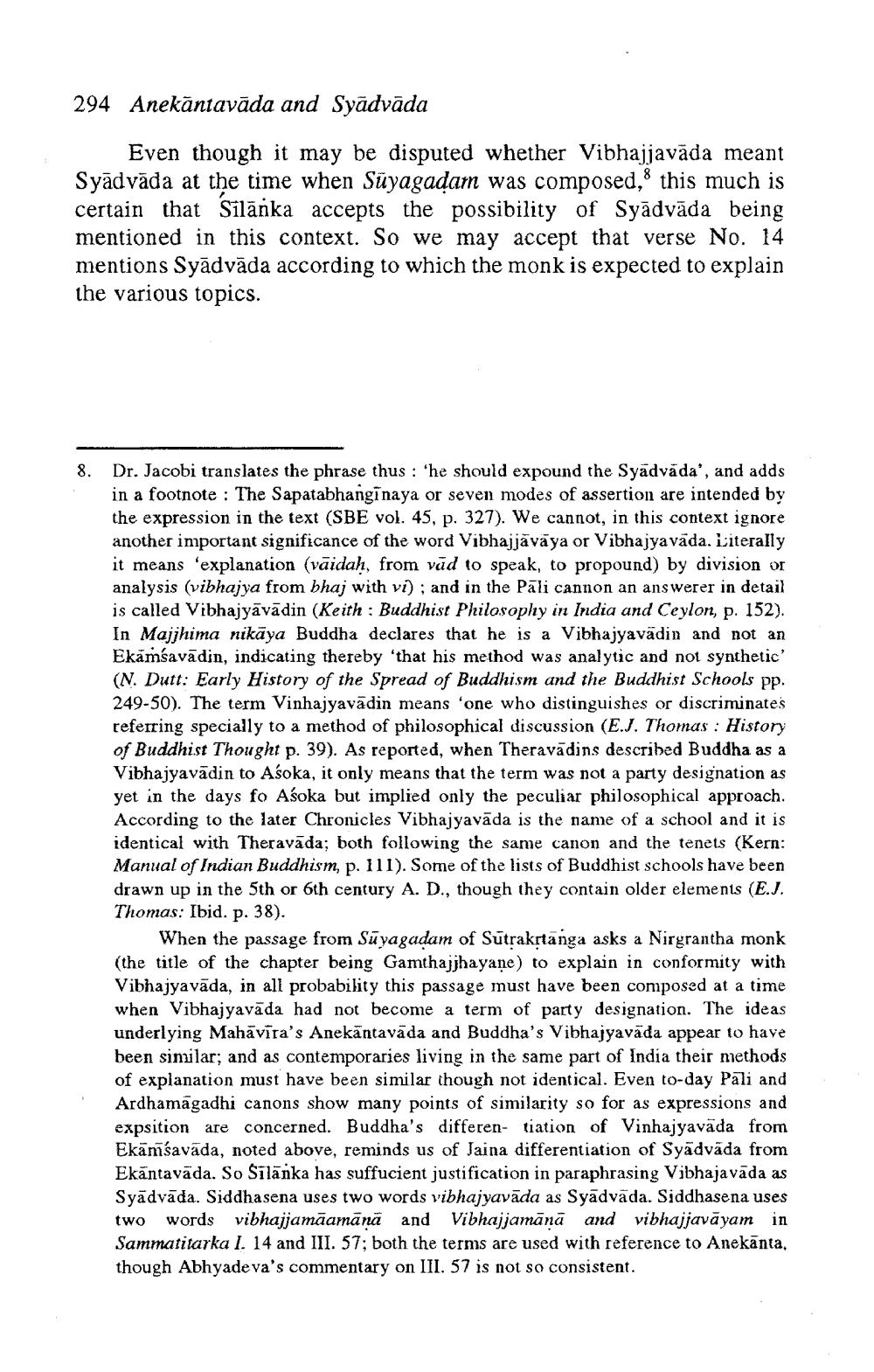________________
294 Anekāntavāda and Syādvāda
Even though it may be disputed whether Vibhajjavāda meant Syādvāda at the time when Süyagadam was composed, this much is certain that Silānka accepts the possibility of Syādvāda being mentioned in this context. So we may accept that verse No. 14 mentions Syādvāda according to which the monk is expected to explain the various topics.
8. Dr. Jacobi translates the phrase thus : 'he should expound the Syadväda', and adds
in a footnote : The Sapatabhangīnaya or seven modes of assertion are intended by the expression in the text (SBE vol. 45, p. 327). We cannot, in this context ignore another important significance of the word Vibhajjāvāya or Vibhajyavada. Literally it means "explanation (väidah, from vād to speak, to propound) by division or analysis (vibhajya from bhaj with vi); and in the Pāli cannon an answerer in detail is called Vibhajyāvādin (Keith : Buddhist Philosophy in India and Ceylon, p. 152). In Majjhima nikāya Buddha declares that he is a Vibhajyavādin and not an Ekāmśavadin, indicating thereby 'that his method was analytic and not synthetic (N. Dutt: Early History of the Spread of Buddhism and the Buddhist Schools pp. 249-50). The term Vinhajyavādin means 'one who distinguishes or discriminates referring specially to a method of philosophical discussion (E.J. Thomas : History of Buddhist Thought p. 39). As reported, when Theravadins described Buddha as a Vibhajyavādin to Asoka, it only means that the term was not a party designation as yet in the days fo Asoka but implied only the peculiar philosophical approach. According to the later Chronicles Vibhajyavāda is the name of a school and it is identical with Theravada; both following the same canon and the tenets (Kern: Manual of Indian Buddhism, p. 111). Some of the lists of Buddhist schools have been drawn up in the 5th or 6th century A. D., though they contain older elements (E.J. Thomas: Ibid. p. 38).
When the passage from Suyagadam of Sutrakrtanga asks a Nirgrantha monk (the title of the chapter being Gamthajjhayane) to explain in conformity with Vibhajyavāda, in all probability this passage must have been composed at a time when Vibhajyavāda had not become a term of party designation. The ideas underlying Mahāvīra's Anekāntavāda and Buddha's Vibhajyavāda appear to have been similar; and as contemporaries living in the same part of India their methods of explanation must have been similar though not identical. Even to-day Pali and Ardhamagadhi canons show many points of similarity so for as expressions and expsition are concerned. Buddha's differen- tiation of Vinhajyavāda from Ekāmšavada, noted above, reminds us of Jaina differentiation of Syadváda from Ekāntavāda. So Sīlanka has suffucient justification in paraphrasing Vibhajavāda as Syadvada. Siddhasena uses two words vibhajyavāda as Syadvāda. Siddhasena uses two words vibhajjamāamānā and Vibhajjamānā and vibhajjavāyam in Sammatitarka l. 14 and III. 57; both the terms are used with reference to Anekanta. though Abhyadeva's commentary on III. 57 is not so consistent.




